
Miranda Jane Richardson is an English actress who has worked extensively in film, television and theatre.

Snow-White is a 1933 American animated short in the Betty Boop series from Max Fleischer's Fleischer Studios. Dave Fleischer was credited as director, although virtually all the animation was done by Roland Crandall, who received the opportunity to make Snow-White on his own as a reward for his several years of devotion to the Fleischer studio. The resulting film, which took six months to complete, is considered both Crandall's masterwork and an important milestone of the Golden age of American animation.

Snow White and the Seven Dwarfs is a 1937 American animated musical fantasy film produced by Walt Disney Productions and released by RKO Radio Pictures. Based on the 1812 German fairy tale by the Brothers Grimm, it is the first animated feature film produced in the United States and the first cel animated feature film. The production was supervised by David Hand, and the film's sequences were directed by Perce Pearce, William Cottrell, Larry Morey, Wilfred Jackson, and Ben Sharpsteen.

Kristin Laura Kreuk is a Canadian actress. Debuting on teen drama Edgemont, she became most known for her roles as Lana Lang in the superhero television series Smallville (2001–2011), Catherine Chandler in The CW sci-fi series Beauty & the Beast (2012–2016) and as Joanna Hanley in the CBC legal drama series Burden of Truth (2018–2021).

"Snow White" is a German fairy tale, first written down in the early 19th century. The Brothers Grimm published it in 1812 in the first edition of their collection Grimms' Fairy Tales, numbered as Tale 53. The original German title was Sneewittchen; the modern spelling is Schneewittchen. The Grimms completed their final revision of the story in 1854, which can be found in the 1857 version of Grimms' Fairy Tales.
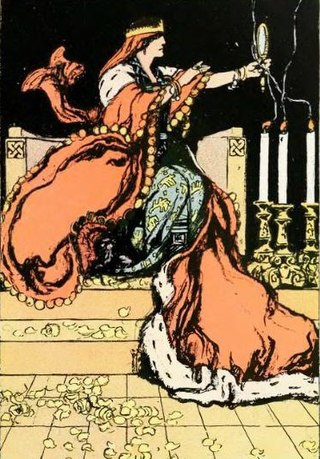
The Evil Queen, also called the Wicked Queen or just the Queen, is a fictional character and the main antagonist of "Snow White", a German fairy tale recorded by the Brothers Grimm; similar stories exist worldwide. Other versions of the Queen appear in subsequent adaptations and continuations of the fairy tale, including novels and films. One particularly notable version is Disney's depiction, sometimes known as Queen Grimhilde. The character has also become an archetype that inspired unrelated works.
Caroline Thompson is an American novelist, screenwriter, film director, and producer. She wrote the screenplays for the Tim Burton-directed films Edward Scissorhands and Corpse Bride and the Burton-produced The Nightmare Before Christmas. She co-wrote the story for Edward Scissorhands and co-adapted a new stage version of the film with director and choreographer Matthew Bourne. Thompson also adapted the screenplay for the film version of Wicked Lovely, a bestselling fantasy series, in 2011, but the production was put into turnaround. She directed Black Beauty (1994); Buddy (1997), which she also wrote; and the television film Snow White: The Fairest of Them All (2001), also as producer and co-writer.
Snow White is a popular fairy tale.

Snow White's Enchanted Wish is a dark ride at the Disneyland, Tokyo Disneyland, and Disneyland Paris theme parks, and formerly at the Magic Kingdom. Located in Fantasyland, it is one of the few remaining attractions that was operational on Disneyland's opening day in 1955, although it has seen several different redesigns over its history. The ride's story is based on Disney's 1937 film, Snow White and the Seven Dwarfs, their first animated feature film.
The Charmings is an American fantasy sitcom that follows Snow White and Prince Charming, awakened from a thousand-year spell, as they adjust from their familiar life in the enchanted forest to the modern ways of 20th century Los Angeles suburbs. The series originally aired from March 20, 1987, to February 11, 1988, on ABC.
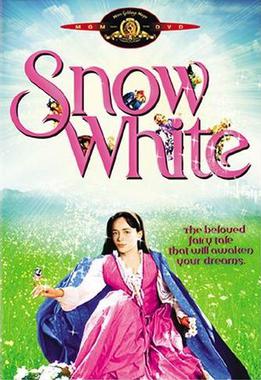
Snow White is a 1987 American musical fantasy film based on the classic 1812 fairytale and released as part of the "Cannon Movie Tales" series. The film was released straight to video. In August 2005 it was released on Region 1 DVD by MGM.

The Seven Dwarfs are a group of seven fictional dwarfs that appear in the 1812 fairy tale Snow White by the Brothers Grimm and other renditions and adaptations.

Snow White is a fictional character and a main character from Walt Disney Productions' first animated feature film Snow White and the Seven Dwarfs (1937). She was originally voiced by Adriana Caselotti. The character of Snow White was derived from a fairy tale known from many countries in Europe with the best-known version being the 1812 tale collected by the Brothers Grimm.

Mirror Mirror is a 2012 American fantasy comedy film based on the fairy tale, "Snow White", collected by the Brothers Grimm. The film follows a young princess named Snow White, who uses the help of a band of seven thieves as well as a prince, to reclaim her throne from her wicked stepmother, the enchantress Clementianna.
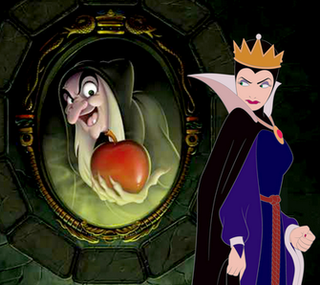
The Evil Queen, also known as the Wicked Queen, Queen Grimhilde, or just the Queen, is a fictional character who appears in Walt Disney Productions' first animated feature film Snow White and the Seven Dwarfs (1937) and remains a villain character in their extended Snow White franchise. She is based on the Evil Queen character from the 1812 German fairy tale "Snow White".
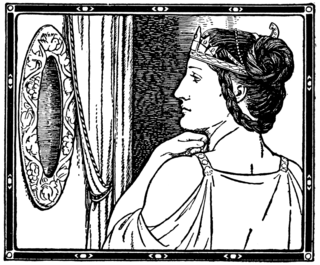
The Magic Mirror is a mystical object that is featured in the story of Snow White, depicted as either a hand mirror or a wall-mounted mirror.
Snow White is a Disney media franchise that began in 1937 with the theatrical release of Snow White and the Seven Dwarfs. It is based on the 1812 fairy tale by the Brothers Grimm.

Snow White and the Seven Dwarfs is a 1938 picture book written and illustrated by Wanda Gág and published by Coward-McCann. Snow White and the Seven Dwarfs was a Caldecott Medal Honor Book in 1939. The book is a twist on the classic tale of Snow White by the Brothers Grimm. Since then it has been republished several times, including in 1999, 2004, and 2013.

Disney's Snow White, or simply Snow White, is an upcoming American musical fantasy film directed by Marc Webb, from a screenplay by Greta Gerwig and Erin Cressida Wilson. Co-produced by Walt Disney Pictures and Marc Platt Productions, it is a live-action remake of Walt Disney's 1937 animated feature film Snow White and the Seven Dwarfs, which itself is loosely based on the 1812 fairy tale of the same title by the Brothers Grimm. The film stars Rachel Zegler as the title character and Gal Gadot as the Evil Queen.
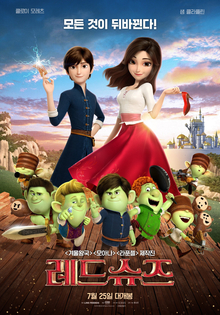
Red Shoes and the Seven Dwarfs, known in Korean as simply Red Shoes, is a 2019 English-language South Korean animated fantasy film produced by Locus Corporation. It is based on the 1812 German-language fairy tale "Snow White" by the Brothers Grimm, and its name is derived from the 1845 Danish fairy tale The Red Shoes by Hans Christian Andersen. The film features the voices of Chloë Grace Moretz, Sam Claflin, Gina Gershon, Patrick Warburton, and Jim Rash.


















